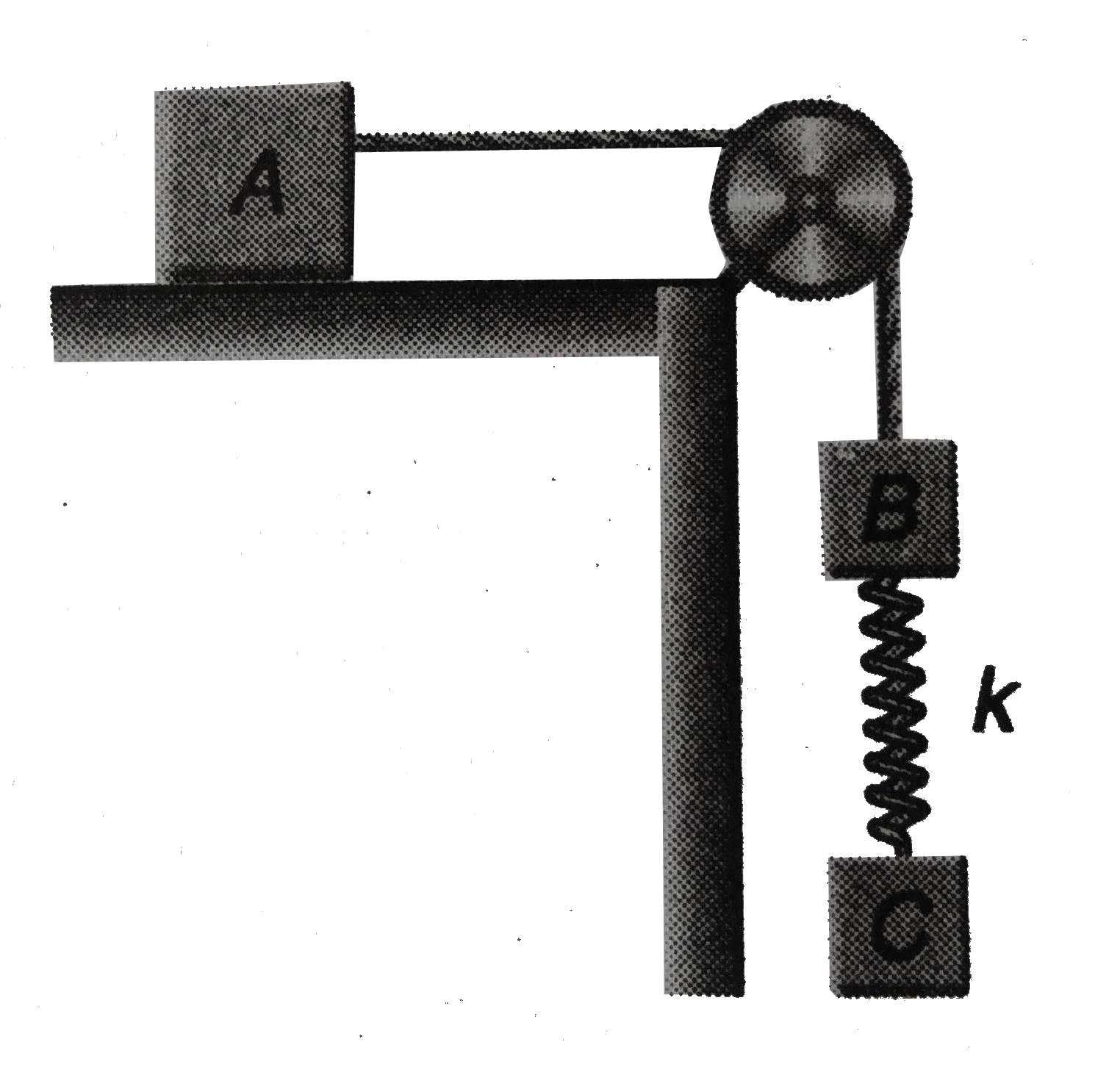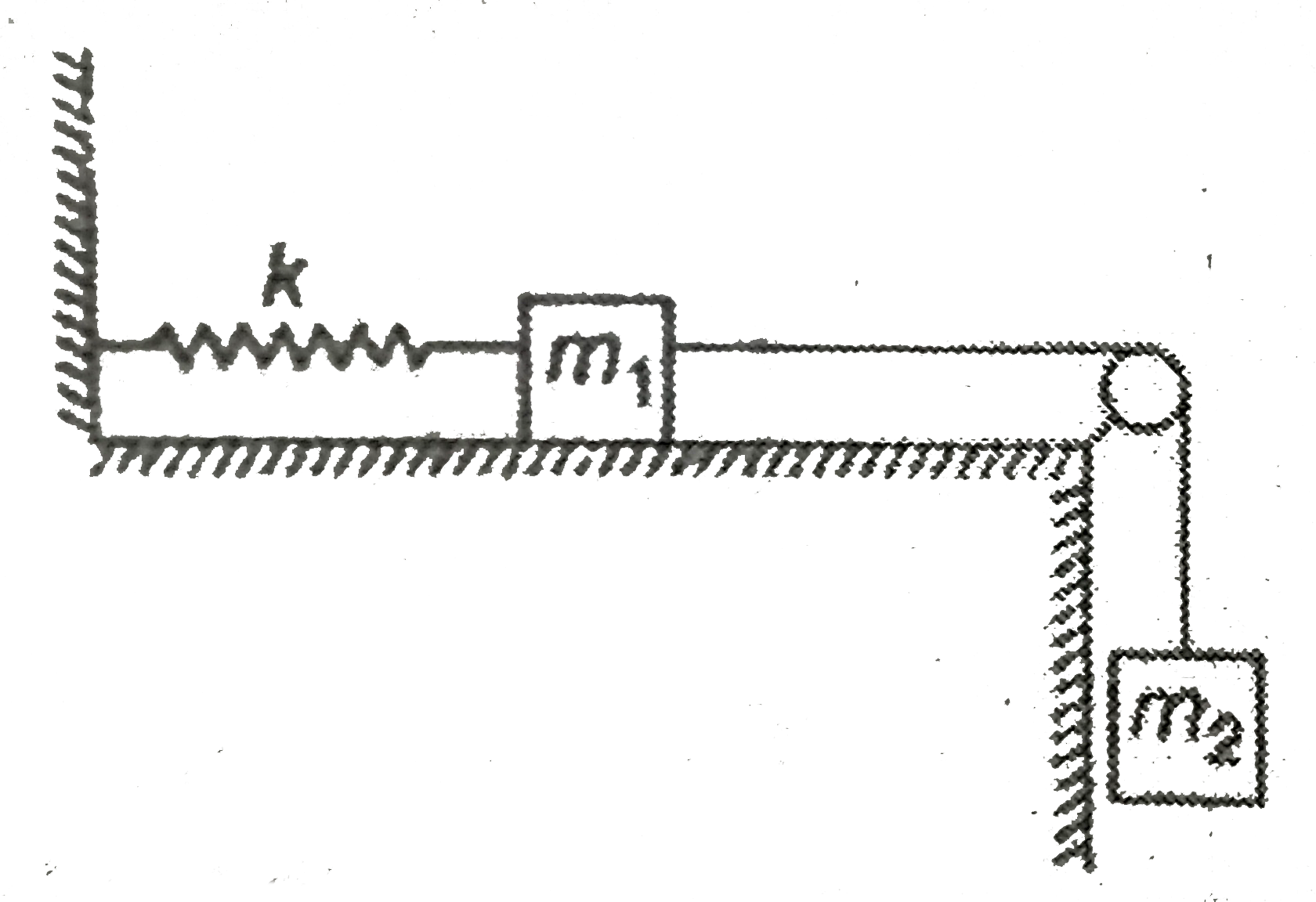In the shown figure, the spring and string is ideal. The spring the stiffness of 100N/m and m=1kg friction exists between mass 2m and surface with coefficient μ=0.8. The system is released with spring from its relaxed position. Based on above data, answer the following question: (take g=10m/s2)

Magnitude of work done by gravity during the motion of system is :
0.8 J
1.6 J
0.4 J
4 J
The correct Answer is:B
Step by step video, text & image solution for In the shown figure, the spring and string is ideal. The spring the stiffness of 100 N//m and m = 1 kg friction exists between mass 2m and surface with coefficient mu = 0.8. The system is released with spring from its relaxed position. Based on above data, answer the following question: (take g = 10 m//s^(2)) Magnitude of work done by gravity during the motion of system is : by Physics experts to help you in doubts & scoring excellent marks in Class 11 exams.
Updated on:21/07/2023Topper's Solved these Questions
Similar Questions
In the figure shown masses of the blocks A, B and C are 6kg, 2kg and 1kg respectively. Mass of the spring is negligibly small and its stiffness is 1000 N//m. The coefficient of friction between the block A snd the table is μ=0.8. Initially block C is held such that spring is in relaxed position. The block is released from rest. Find (g=10m/s2).

(a) the maximum distance moved by the kinetic C.
the acceleration of each block, when clongation in the spring is maximum.
View SolutionIn the shown figure, the spring and string is ideal. The spring the stiffness of 100N/m and m=1kg friction exists between mass 2m and surface with coefficient μ=0.8. The system is released with spring from its relaxed position. Based on above data, answer the following question: (take g=10m/s2)

After what displacement of mass 2m, its velocity becomes maximum ?
View Solution
Knowledge Check
In the shown figure, the spring and string is ideal. The spring the stiffness of 100N/m and m=1kg friction exists between mass 2m and surface with coefficient μ=0.8. The system is released with spring from its relaxed position. Based on above data, answer the following question: (take g=10m/s2)

Maximum extension in spring is :A8 cmB4 cmC36 cmD20 cmIn the shown figure, the spring and string is ideal. The spring the stiffness of 100N/m and m=1kg friction exists between mass 2m and surface with coefficient μ=0.8. The system is released with spring from its relaxed position. Based on above data, answer the following question: (take g=10m/s2)

Magnitude of net work done by spring after the system is released for motion is:A0.8 JB1.6 JC0.32 JD2.40 JIn the shown figure, the spring and string is ideal. The spring the stiffness of 100N/m and m=1kg friction exists between mass 2m and surface with coefficient μ=0.8. The system is released with spring from its relaxed position. Based on above data, answer the following question: (take g=10m/s2)

Frictional force acting on the mass 2m when it finally comes to rest is:A16 NB8 NC12 NDzero
In the system as shown in figure, the blocks have masses m1 and m2, the spring constant is k, coefficient of friction between the block of mass m1 and the surface is μ. The system is released with zero initial speed from the position where the spring is in its natural length.

View SolutionThe system is released from rest with both the springs in unstretched positions. Mass of each block is 1 kg and force constant of each spring is 10N/m.

Extension of horizontal spring in equilibrium is
View SolutionIn the shown figure, four blocks A,B,C and D are connected by three ideal strings. Coefficient of friction between A,B and surface is 0.2. The mass A,B and D are of 5kg and C is of mkg.fA and fB are the frictional forces action on A and B respectively. The system is allowed to move. Based on the above data answer
the following questions. ( Take g=10m/s2)

If m=4kg then :
View SolutionIn the shown figure, four blocks A,B,C and D are connected by three ideal strings. Coefficient of friction between A,B and surface is 0.2. The mass A,B and D are of 5kg and C is of mkg.fA and fB are the frictional forces action on A and B respectively. The system is allowed to move. Based on the above data answer
the following questions. ( Take g=10m/s2)

If m=6kg, then:
View SolutionIn the shown figure, four blocks A,B,C and D are connected by three ideal strings. Coefficient of friction between A,B and surface is 0.2. The mass A,B and D are of 5kg and C is of mkg.fA and fB are the frictional forces action on A and B respectively. The system is allowed to move. Based on the above data answer
the following questions. ( Take g=10m/s2)

If m=5kg, then
View Solution
